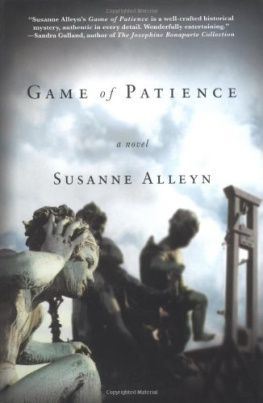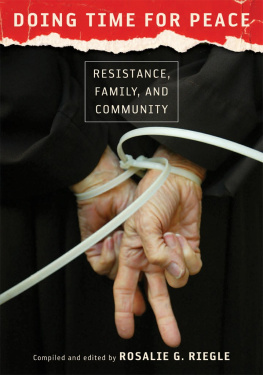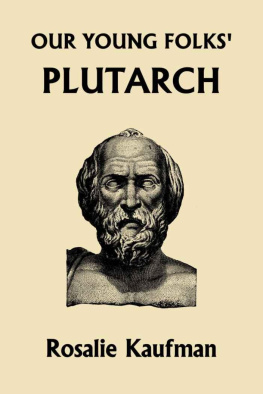GAME OF PATIENCE
by
Susanne Alleyn
An Aristide Ravel Mystery
GAME OF PATIENCE 2006 by Susanne Alleyn. All rights reserved. Published in the United States of America. No part of this book may be used or reproduced in any manner whatsoever without written permission except in the case of brief quotations embodied in critical articles or reviews. For information, please contact Don Congdon Associates, Inc., 156 Fifth Avenue, Suite 625, New York, NY 10010, USA
email:
Also by Susanne Alleyn
A FAR BETTER REST
A TREASURY OF REGRETS
THE CAVALIER OF THE APOCALYPSE
PALACE OF JUSTICE
Acknowledgments
For their unflagging friendship, affection, interest, encouragement, and most of all, endurance, as this novel slowly evolved, a gigantic thank you, as always, to Johanna and also to Erika Vause, Kristi Corlett, Benjamin Cooper, and the Hudson Writers Roundtable, particularly Dan Region, Sean Springer, Ned Depew, and Carol Lavender. Equal thanks must go to Peter Wolverton and Don Congdon, my two sternest and best critics.
I also owe a debt of gratitude to Professors Laura Mason, Michael Sibalis, and Clive Emsley for their kind and invaluable assistance with details of 18th-century French law and policing. Merci tous .
To Berenice and Walt McDayter, with love and thanks always
Foreword
I have followed general European practice in the naming of floors in buildings; the first floor is one flight up from the ground floor, and so on.
Much of the tangle of medieval streets in the heart of Paris disappeared during Haussmanns extensive rebuilding of the city in the 1860s. Many other streets have had their names, or the spelling of their names, changed over the course of the past two centuries. To make matters even more confusing, many street names still in use today were temporarily changed or altered during the most radical phase of the Revolution to eliminate references to royalty, aristocracy, or Christianity. All streets and street names mentioned in this novel, however, existed in the 1790s.
TERMS
Bourreau (plural bourreaux ): A hangman or professional torturer. Used as a derogatory term for any executioner, including the master executioner, who held a largely ceremonial and supervisory office; he was a title-holder and officer of the court, and rarely performed the dirty work of executions himself, beyond sometimes releasing the lever of the guillotine.
Commissaire: After 1790, a local police official, in charge of a section (administrative district) of Paris; the commissaire combined the approximate functions of precinct commander and chief investigator.
Commissariat: Police headquarters for a Parisian section.
Faubourg: A suburb or, less precisely, a neighborhood at the edge of the medieval center of a city; areas of Paris such as the faubourg St. Germain, the faubourg St. Marcel, and so on, were so named in the Middle Ages, when they were parishes lying outside the twelfth-century walls, but by the eighteenth century they were well within the city limits.
Htel : Can mean a hostelry, a large public building ( htel de ville, city hall; htel-Dieu, charity hospital), or a large private town house or mansion ( htel particulier ). I have used the French form, with the circumflex over the o, whenever referring to a mansion or municipal hall, and the unaccented English word when referring to public accommodations.
Inspector: After 1790, a low-level police officer roughly corresponding to a uniformed sergeant or senior beat cop in a modern police force.
Jacobin: A member of the longstanding, left-wing political club which, from 1792, called itself Society of Jacobins, friends of Liberty and Equality. In Paris, it met in the former monastery of the Dominican Brothers (nicknamed Jacobins, from their mother house on Rue St. Jacques). The term grew to include any radical republican. The Jacobin Club was closed down in 1794 after the fall of the Robespierrists.
Matre dhtel: A high-ranking house servant, equivalent to butler or steward.
Money: The most common standard unit of eighteenth-century French currency was the livre, although there was no one-livre coin. Twenty sous (which were further divided into the small change of copper deniers and liards) made up a livre; six livres a silver cu; twenty-four livres a gold louis dor. In 1790, the National Assembly introduced paper currency, the assignats, which promptly plummeted in value and incited people to hoard coinage. The franc, roughly equivalent to a livre, was introduced in 1795.
Palais-galit: In the 1780s the Duc dOrlans built the Palais-Royal, an enclosure of elegant buildings with ground-floor shopping arcades, to surround the extensive gardens of his familys Paris mansion, and opened it to the public. It was temporarily renamed during the Revolution to Palais-galit (Equality Palace, after the ex-duke, who had renounced his title and renamed himself Philippe galit), to follow republican fashion during the Terror. Though quiet today, in the eighteenth and early nineteenth centuries the Palais-Royal was the center of racy, fashionable social life, chic shopping and dining, and expensive debauchery.
Police: The duties of the police of eighteenth-century Paris extended far beyond the prevention and investigation of crime and the maintenance of public order. Essentially city administrators, they supervised all kinds of public affairs which today, in a large European or American city, would be managed by various departments of health, sanitation, public welfare, housing, trade, the fire department, and even public morals.
President (of a court): The chief or presiding judge at a trial, during both the ancien rgime and the Revolution.
Republican calendar or French Revolutionary calendar: Used officially in France from 1793 to 1809. It consisted of twelve months with three ten-day weeks in each, and five additional festival days (six in leap years) completing the calendar. The republican year began on September 22 of the Gregorian calendar and was dated from September 22, 1792 (the day the French Republic was established), though it was not put into official use until October of 1793, a month into Year II.
Section: One of forty-eight administrative areas of Paris, replacing the numbered districts of the prerevolutionary regime, consisting of a few square blocks in the heart of the city, and a wider area in the more sparsely populated outer quarters. Their names frequently changed during the Revolution, as personages or political movements grew popular or were disgraced; the Section du Palais-Royal, for example, became Section du Palais-galit in 1792, after the fall of the monarchy; then Section de la Butte-des-Moulins in 1793; then Section de la Montagne, within the year; and then once again Section de la Butte-des-Moulins in late 1794, after the decline of the Montagnard faction. Neither the sections nor the numbered prerevolutionary districts bore any relation to the modern arrondissements.
CHAPTER 1
9 Brumaire, Year V of the Republic
(October 30, 1796)
Aristide Ravel did not often set foot in the Place de Grve. It was an ill-omened place, the Golgotha of Paris, the site of uncounted butcheries across five centuries, and he loathed public executions.
He shivered and cast a fleeting glance toward the guillotine, waiting high above the heads of the crowd, as the sharp breeze of a Parisian October whipped lank dark hair into his eyes. Perhaps, he brooded, not for the first time, he was over-sensitive for a man who worked for the police. Police officials, his friend and employer Brasseur among them, did their duty and washed their hands of the affair, leaving the rest to the Criminal Tribunal and the public prosecutor. But the police and the law courts, he thought, in their determined efforts to maintain order in a city still unsettled after seven years of revolutionary upheaval, sometimes could be wrong.












